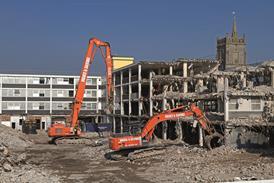The collapse of �ڶ����� Schools for the Future has left a lot of bad feeling, but in some ways the programme deserved to die - and we now have the chance to do it better
Two steps forward, three strides back - at least that is how it feels at the moment for those of us working at the sharp end of construction. The demise of the �ڶ����� Schools for the Future (BSF) programme was long predicted but the breadth and depth of the cuts has taken most of us by surprise. By the time Michael Gove was onto list number five of project casualties, it was a bit like watching the end of Blackadder where all your favourite characters were mown down one after another. I am not sure that the hope that privately funded work will fill the hole created by the cancellation of public sector activity is grounded in reality.
Following the crash of 2008, the banks are still nervous about funding large capital projects and so private work will still be thin on the ground, and the margins available on those projects shallow for some time to come. According to one member of the coalition government, some £60bn of lending to the business sector has been withheld in the past 17 months. The banks argue that regulators are forcing them to hold ever larger capital and reserves to prevent a repeat of the global meltdown. There will be no private client investment in property and construction if they cannot get access to funding, and those contractors, architects and professional consultants that relied on public sector work will disappear, never to return, if they cannot get an overdraft to see them through this sticky period. The banks blame the government, the government blames the banks and we are all stuck in the middle.
Just as history may be repeating itself in terms of public sector cuts, I note that we are also seeing old faces return from the past. It is interesting to see that Sir John Egan has been appointed to examine what remains of the BSF. This is the man who ended his 1998 report, Rethinking Construction, by saying: “What we are proposing is a radical change in the way we build. We wish to see, within five years, the construction industry deliver its products to its customers in the same way as the best consumer-led manufacturing and service industries.”
Bearing in mind that the new education secretary has just described the BSF system as “longwinded”, “inefficient” and “expensive”, then clearly the last government must have ignored Egan’s advice. So now the new government is using the same man to revisit problems he identified more than 12 years ago. Egan must be getting a strong sense of déjà vu.
When Gove announcing the cuts, he characterised the BSF programme as having “massive overspends, tragic delays, botched construction projects and needless bureaucracy”. QSs, contractors, and project managers were all culpable in the mistakes of the past. And architects don’t escape Gove’s implied criticism: “One BSF school was built with corridors so narrow the whole building had to be reconstructed; another had to be closed because the doors could not cope with high winds.”
Most of us involved in the BSF process would agree with a lot of what Gove says and we hope that he appreciates that the system was imposed on our industry by local and national government. It was also extremely costly and wasteful for our industry to require several contractors to originate bespoke designs. Surely it would have been better value for all concerned if a design were adopted and the contractors and project managers priced it? This was highlighted by many working at the sharp end of BSF, but sadly ignored. Many angry headteachers and disillusioned students are paying the price, as is our industry.
I am afraid that lost in the political acrimony, angst and anger is the fact that much of the work undertaken in the area of education rebuilding has been first rate. In spite of an appallingly bureaucratic and wasteful system, which was dictated to and not by our industry, it did produce some fine schools, colleges of further education and university buildings. When Egan wrote his first report, about 3% of school leavers went on to further education. This figure is now more than 50%; all these students needed somewhere to live and study and we have built it for them.
Construction is still a vital part of the government’s economic regeneration plans.
It is going to have to re-invent itself, but it has always been the case that we adapt and survive. The previous government ignored Egan’s advice, but perhaps now we shall see a more enlightened approach and the views of those who have to design, price, manage and construct what remains of the BSF programme will be considered.
Richard Steer is the senior partner at Gleeds























No comments yet